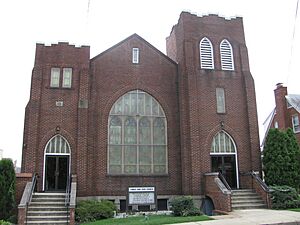Nauck, Virginia facts for kids
Nauck is a neighborhood in Arlington County, Virginia. It's also known as Green Valley. It is located in the southern part of Arlington. The neighborhood is next to Four Mile Run and Shirlington to the south. It borders Douglas Park to the west and I-395 to the east. Columbia Heights and the Army-Navy Country Club are to the north. A small part of the neighborhood also touches the City of Alexandria.
The area got the name "Nauck" from John D. Nauck. He was a former soldier who bought and sold land here from 1874 to 1900. This helped the neighborhood grow. In 2019, the Nauck Civic Association decided to change its name. They became the "Green Valley Civic Association." This was to remove the name of a Confederate soldier. The association now represents a neighborhood that has a long history as a Black community. The county government will update its maps with the new name. However, the county board has not yet changed the name of the neighborhood itself.
Contents
A Look Back: History of Green Valley

The land where Nauck is today has a long history. In 1719, John Todd and Evan Thomas received a land grant here. Later, Robert Alexander owned the land. In 1778, the land became part of John Parke Custis's large Abingdon estate.
Early Settlers and the Railroad
In the mid-1800s, Gustavus Brown Alexander owned much of this area. It was called Green Valley back then. During this time, African Americans began to buy land and live in the Nauck area. Levi and Sarah Ann Jones were some of the first Black property owners.
In 1859, a railroad line started running through the area. It was called the Alexandria, Loudoun and Hampshire Railroad. This line later became part of the Washington and Old Dominion Railroad. It went through the Four Mile Run valley. There were stations named Nauck and Cowdon. The train carried goods until 1968. However, passenger service stopped in 1932 during the Great Depression.
Civil War and New Beginnings
During the American Civil War, the Union Army built forts like Fort Barnard here. They also set up camps for soldiers. After the war ended in 1865, Thornton and Selina Gray bought land in the area in 1867. They were an African American couple who had been enslaved at Arlington House.
From 1874 to 1875, John D. Nauck bought about 69 acres of land. He was a former Confederate Army soldier from Germany. Nauck lived on his property and sold off smaller pieces of land.
After the war, many African American families moved to the area. Some came from Freedman's Village. In 1876, William Augustus Rowe, a Black leader from Freedman's Village, bought property here. In 1885, a map called "Map of the Town of Nauck" was officially recorded.
Growing Community and Challenges
Nauck grew slowly in the late 1800s. In 1874, a church group bought land to move their African Methodist Episcopal Zion Church building. It was called the Little Zion Church. This church building also held a public school, later known as the Kemper School. In 1885, the school board built a new one-room school. A larger brick school was built in 1893. Today, the Drew Model Elementary School is on that site.
In 1898, an interurban electric trolley line was built. It connected Nauck to Rosslyn and downtown Washington, D.C.. This trolley line helped the neighborhood grow even more.
However, the 1902 Virginia Constitution caused problems. It created racial segregation across the state. This limited the rights of African Americans. It also slowed down Nauck's growth. Even so, people continued to divide their land for more homes.
In 1922, the Lomax African Methodist Episcopal Zion Church was built. It is a successor to the Little Zion Church. This church was added to the National Register of Historic Places in 2004.
During World War II, the government built Paul Dunbar Homes. These were simple homes for African Americans. They provided affordable housing during the war.
The building of The Pentagon during the war also affected Nauck. It destroyed several older Black communities. Many people who lost their homes moved to Nauck. This helped the neighborhood grow and increased its Black population.
By 1952, most of Nauck was developed. The neighborhood continued to grow throughout the rest of the 20th century.
Changes and New Plans
Green Valley is changing. Many older houses are being torn down. They are being replaced with bigger, newer homes. This is because the value of land in the neighborhood has gone up. New housing projects like the Townes of Shirlington and Shirlington Crest have been built. There is also The Macedonian, which is an affordable housing project.
The area along Shirlington Road is also seeing big changes. In 2004, Arlington County made a plan for the Nauck Village Center. This plan helps guide how the main business area of Nauck will develop.
In 2018, the county made another plan for the Four Mile Run Valley. This area used to have industrial businesses. The plan helps decide how this area will develop in the future. It looks at things like being environmentally friendly, creating open spaces, and improving transportation.
Important Places
In 2013, the Green Valley Pharmacy in Nauck became a local historic district. This means it's a special place with historical importance. In 2014, a historical marker was put up at the Pharmacy.
Fun in the Parks
Green Valley has several parks for everyone to enjoy.
- Nauck Park: This park has restrooms, picnic tables, and a playground for school-aged kids.
- Drew Park: Located next to the Charles Drew Community Center. It has a playground, a basketball court, a baseball diamond, and a sprayground.
- Fort Barnard Park: This park is on the site of Fort Barnard, a fort built by the Union Army during the Civil War. The park has "fort"-themed play equipment, a mosaic, and a hopscotch area. It also has a playground, picnic shelter, a baseball diamond, and a basketball court.
- Fort Barnard Heights Park: A smaller park with a picnic table, benches, and open green space.
- Four Mile Run Valley Park: This is a large open space along Four Mile Run. It includes Jennie Dean Park and the Shirlington Dog Park, which are both in Nauck.
- Washington & Old Dominion Railroad Trail: The start of this long trail is in Nauck. The trail follows Four Mile Run and goes northwest for about 45 miles. It's great for walking, running, and biking.
Schools
Green Valley is home to Dr. Charles R. Drew Elementary School. It is part of Arlington Public Schools.
Who Lives Here: Demographics
Based on the 2010 Census, Green Valley's population was:
- 35.9% non-Hispanic Black or African-American
- 27.3% non-Hispanic White
- 25.7% Hispanic or Latino
About the Neighborhood Name
Around 1821, a large estate called "Green Valley Manor" was built nearby. This name "Green Valley" was used for the area for a long time.
The neighborhood later got the name "Nauck" from John D. Nauck. He was a former Confederate Army soldier who bought and sold land here from 1874 to 1900.
In February 2019, a resident suggested changing the name of the Nauck Civic Association. They felt the historically Black neighborhood should not be named after a Confederate soldier. They also said the area was called Green Valley from the 1700s to the 1970s.
The Civic Association then voted to change its name to the "Green Valley Civic Association." The Arlington County Civic Federation approved this change. The county government will update its records and maps with the new association name. However, the County Board has not yet voted to change the name of the neighborhood itself.



